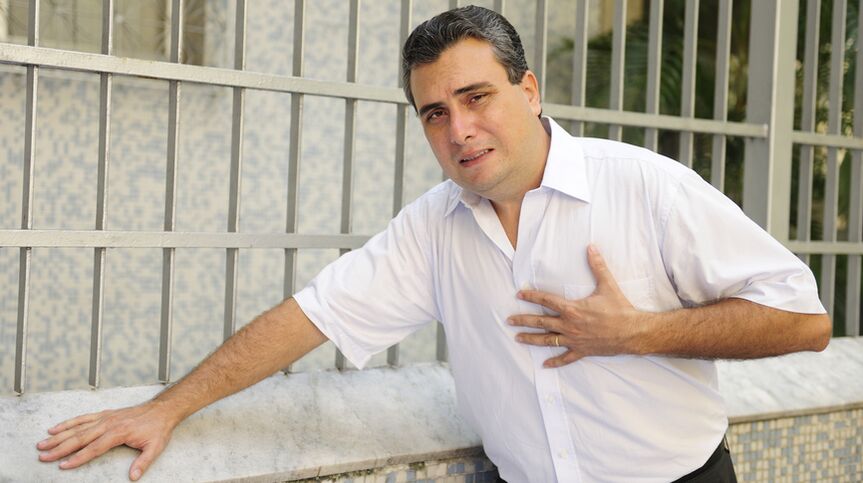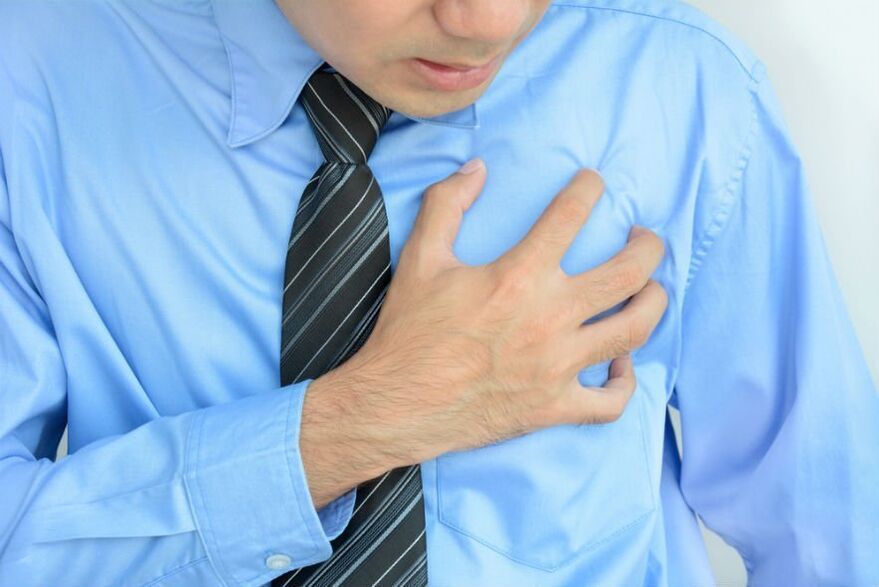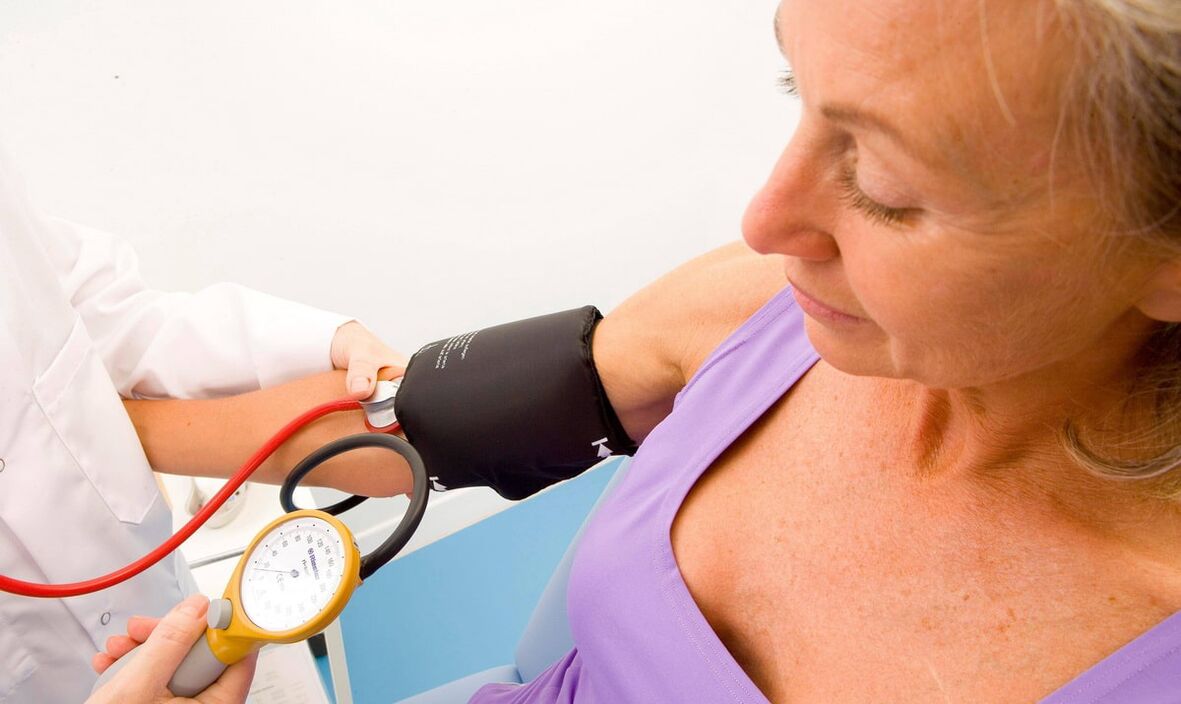
Painful sensations in the area of the heart force patients to consult a cardiologist. Anxiety, irritation and fear of one's own life appear. But not all unpleasant symptoms are directly related to heart problems. Even thoracic osteochondrosis - symptoms, sensation - pain in the heart just as often causes diseases of this organ.
Pain behind the abdomen, closer to the back or even near the diaphragm, when the vertebrae are damaged, can often occur, regardless of the stage of the pathology. And the mechanism of the unpleasant symptom has several characteristics.
Mechanism of symptom development
During osteochondrosis, the interruptions in the heart cannot happen by themselves; They develop only as an echo of the main disease:
- Thinning of intervertebral structures. The distance between the bone elements and the cartilage decreases, which leads to the limitation of the nerve roots. As a result, painful sensations arise, which, in the presence of destructive processes of the thoracic or cervical spine, often radiate to the heart.
- Changes in the heart muscle. Due to the disease, the sensations spread to the heart muscle, e. year"Echo" of pain.
- Involvement of the upper limbs in the process. The effect of osteochondrosis on the heart can be caused by excessive tension in the muscles of the arms. As a result, the pain is transmitted to the heart muscle, but the ECG does not show any abnormalities.
- Changes in the structure of the waist. The position of the abdominal organs changes, as a result of which stress increases and heart rate changes.
- Muscle spasms and changes in blood circulation. In osteochondrosis, pain in the heart appears in response to changes in blood flow in the large spinal arteries. The heart rate increases because the blood has to pass through a narrower passage.
- Severe destruction of the intervertebral discs. Nerves are pinched, causing pain in the heart area. Hypoxia develops gradually. It also involves the functioning of the brain, as a result of which the usual functioning of the internal organs is changed.
- due to constriction of arteriesand nerve fibers, high pressure may appear. Because of this, painful sensations appear in the heart.
You can distinguish heart pain from the manifestation of osteochondrosis by certain symptoms.
Signs of osteochondrosis with painful sensations
Heart syndrome - pain in the heart due to osteochondrosis in the chest - develops in many patients.Symptoms will have the following characteristics:
- pressing, dull pain in heart;
- discomfort gradually increases, silent, not so pronounced;
- The pain lasts for a long time, covers the chest, causes palpitations;
- There is no sharp intensity of pain due to the destruction of the cartilage between the vertebrae;
- Almost always, a symptom such as a feeling of warmth behind the chest helps to distinguish heart pain from osteochondrosis;
- Heart drugs (nitrates) do not help relieve pain;
- If a person begins to move the upper limbs, the pain intensifies.

If the cervical spine is involved in the process, then pain is felt in the spine.
Some patients note that the pain is of a different nature: the discomfort covers the left side of the chest, hurts the muscles, sometimes spreads to the shoulder, neck and face, and the attack can last for several days.
In case of compression of the vertebral artery, additional symptoms appear: weakness, dizziness, spots, and in severe cases, the patient loses consciousness. Also, during heart pain, hearing and vision are reduced and blood flows to the face. If a person takes drugs for hypertension, they do not help him.
Differences in pain
There are several ways to distinguish heart pain from osteochondrosis, the main methods are MRI and ECG examination.In addition, you should know what happens with damage to the thoracic cartilage between the vertebrae and what does not happen with heart disease:
- The pain is moderate, increases and lasts for a long time. Symptoms are more severe during a heart attack;
- If you press your chin to your chest, the pain of osteochondrosis will intensify;
- If the pain is aggravated by movement and exercise, it is osteochondrosis;
- Panic, fear and anxiety always appear during heartache.
Neuralgia itself is safe, but can be aggravated when bending the body in different directions or making sharp turns. Pain can be relieved with analgesics.
Serious heart disease and osteochondrosis
You need to know how your heart hurts during osteochondrosis of the chest region, especially to distinguish neuralgia from life-threatening conditions. In chronic ischemic heart disease, the pain appears very acutely, in 3-5 minutes. Sensations of a tense nature do not allow breathing, and after nitrates the symptoms disappear immediately.
If the risk of myocardial infarction is high, then you should remember that in this condition a person may lose consciousness, experience nausea and severe chest pain. The pain of osteochondrosis is never so acute.
But VSD (dystonia) symptoms can be similar. But unlike heart pain during osteochondrosis, a person with this pathology experiences tachycardia, bradycardia, a sense of fear, gets tired quickly and feels constant weakness. The pain is usually aching and dull, and in osteochondrosis it is compressive.
Palpitations
With osteochondrosis, the heart can not only hurt, but also suffer from angina, arrhythmia and tachycardia. This happens due to spasm and compression of the artery.During osteochondrosis, the following characteristics are manifested:
- increased heart rate during rest, increased rhythm during exercise;
- smooth rhythm without interruptions;
- wave-like heat attacks;
- Tachycardia may be accompanied by presyncope.
Symptoms disappear if quality treatment of the disease is carried out.

Extrasystole
Extrasystole is a condition in which the sensation of a second cardiac arrest appears. In osteochondrosis, this complication causes real panic. However, this unusual condition is normal for the human body. True, most people do not notice such a process.
Extrasystole is a kind of "pause" in the work of the heart muscle. Surprisingly, such short breaks are vital for the body.
Such "pauses" happen to people, regardless of their age, weight and daily physical activity.
Pressure during osteochondrosis
High blood pressure is often among the symptoms of thoracic osteochondrosis. But this pathology may have other causes. In osteochondrosis, the arteries, veins and blood vessels are compressed and the nutrition of the brain and other organs deteriorates.

Patients start taking medication to treat this problem, which causes the blood to stop flowing to the brain again. Oxygen starvation and lack of nutrients develop. A person suffers from such symptoms as: weakness, drowsiness, pain and dizziness, pale skin, nausea.
Dealing with painful feelings
After it became possible to distinguish heart pain from osteochondrosis, the treatment of the disease should be differentiated. If all the symptoms are related to the injury of the thoracic spine, then you cannot take medicines to relieve the pain in the heart.
Therapy should eliminate the causes of osteochondrosis or minimize them. Regular, systematic treatment has been proven to help relieve tension, spasms, and tension in nerve fibers.Since the heart and osteochondrosis are closely related, treatment should begin with the spine during exacerbations:
- A person should not move much, bed rest is recommended.
- Nonsteroidal anti-inflammatory drugs or glucocorticosteroids are prescribed to relieve acute pain.
- Local medications are also used, which are good for relieving pain due to osteochondrosis.
- Physiotherapy helps in the early stages of the disease, but is rarely used to relieve pain. Only during the recovery period after an exacerbation.
- Manual therapy is a very effective method of restoring vertebrae, removing spasms, tension and swelling of surrounding tissues.
- Exercise therapy and sports are also prescribed, which are useful for osteochondrosis in the chest.
- In addition, you can use folk recipes - baths and compresses - they are very relaxing and have a positive effect on the emotional state of patients.
- Diet is equally important in the treatment of osteochondrosis. Adequate amounts of plant-based foods, healthy fats, and proteins are essential to repair damaged tissue. A balanced diet can also help you lose excess weight.

The best way to determine whether you suffer from osteochondrosis or heart disease is a medical examination. With the help of an X-ray and a simple ECG, you can find out what sensations are related to a particular disease.














































